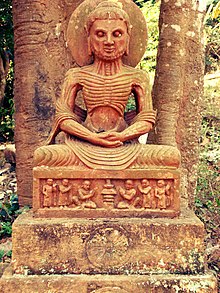Lalitgiri
| Lalitgiri | |
|---|---|
| ଲଳିତଗିରି | |

A skeleton Buddha
|
|
| Basic information | |
| Location | India |
| Geographic coordinates | 20°35′22″N 86°15′02″E / 20.5894°N 86.2506°ECoordinates: 20°35′22″N 86°15′02″E / 20.5894°N 86.2506°E |
| Affiliation | Buddhism |
| State | Odisha |
| Region | coastal |
| Status | Preserved |
Lalitgiri (Odia: ଲଳିତଗିରି) (also known as Naltigiri) is a major Buddhist complex in the Indian state of Odisha comprising major stupas, 'esoteric' Buddha images, and monasteries (viharas), one of the oldest sites in the region. Together with the Ratnagiri and Udayagiri sites, Lalitgiri is part of Puspagiri University located on top of hills of the same names. The three complexes are known as the "Diamond Triangle". Significant finds at this complex include Buddha's relics. Tantric Buddhism was practiced at this site.
Lalitgiri is a major center of Buddhism hemmed between the Parabhadi and Landa sandstone hills in the standalone Assian hill range. It is situated in the Mahanga Tahsil in Cuttack district. Bhubaneswar, the state capital of Odisha, is 90 kilometres (56 mi) from the site, while Cuttack is 60 kilometres (37 mi) away; Udaigiri is 8 kilometres (5.0 mi) from Lalitgiri and Ratnagiri is a further 5 kilometres (3.1 mi) away. Bhubaneswar is well connected by road, rail and air services with the rest of the country.
The first identification of archaeological antiquities from the Diamond Triangle sites was conducted in 1905 by M.M. Chakravarty, the then Sub Divisional Officer in Jajpur. Later, in 1927 and 1928, R.P. Chanda of the Indian Museum in Kolkata documented the site in the Memoirs of Archaeological Survey of India (ASI). In 1937, the site was officially declared a protected monument by the central government. In 1977, some excavations were done at the site by the Utkal University. Detailed excavations by the Bhubaneswar Circle of the Archaeological Survey of India were conducted between 1985 and 1991. From these investigations, it has been inferred that Lalitgiri, one of the earliest Buddhist sites in Orissa, maintained a continuous cultural sequence starting from the post Mauryan period (322–185 BC) till 13th century AD. It is also inferred that this site maintained a continuous of presence of Buddhism, unbroken, from 3rd century BC to 10th century AD.
...
Wikipedia

